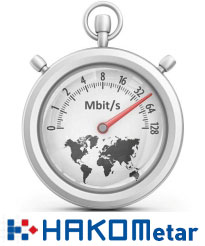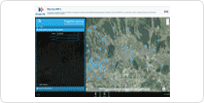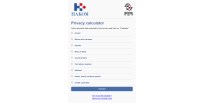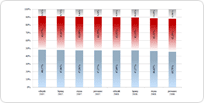Hakom - Croatian Post and Electronic Communications Agency
e-Agency
Users:
Cost Estimator
The Holder of Framework Programme
GIS portal
Privacy calculator
Application ''Quiz''
Market survey
HAKOM starts with new measuring activities regarding interferences coming from Italy
PRESS REALESEDue to favourable conditions for spreading the electromagnetic waves, long-term interferences are even more pronounced in the summer time. Last year, some of the disturbances were eliminated by switching off dominant interfering TV transmitters, but the interferences caused by the Italian transmitters with the Croatian TV channels have not been completely eliminated yet.
ZAGREB, July 9, 2018 – This summer, the experts from the Croatian Regulatory Authority for Network Industries (HAKOM) started with measuring activities regarding the interferences coming from Italy, which are causing problems to the Croatian radio and small TV channels. From July to September, the extensive measuring of interferences coming from Italy in VHF and UHF frequency bands will be carried out, aimed at analogue FM and digital terrestrial radio (T-DAB) and digital television (DVB-T). The measuring campaign will cover the areas of the Adriatic coast and islands. It refers to HAKOM’s measuring activities carried out during the summer months, when, due to more favourable conditions for spreading the electromagnetic waves, the problem of the Italian interferences is even more pronounced. This activity is the result of HAKOM’S long-term efforts. In addition to numerous measuring activities and reports of interference, HAKOM continues to emphasize the problem trying to solve it through bilateral negotiations and international institutions such as the ITU and the Working Group on Cross-Border Coordination at the Advisory Radio Spectrum Management Policy Group of the European Commission. The result of these HAKOM’s efforts was last year's switch-off of the most dominant interfering TV transmitters in specific Italian regions, what solved the problem regarding the majority of the Italian TV interferences, thus significantly improving the reception of Croatian programmes in digital regions D5 (Istria and Primorje-Gorski Kotar County, D7 (Zadar and Šibenik-Knin County), D8 (Split-Dalmatia County) and D9 (Dubrovnik Neretva County).
However, the interferences of the Italian transmitters with the Croatian TV channels have not been completely eliminated and their removal is also important for the future redesign of the digital TV network in the Republic of Croatia, in order to allow the implementation of new mobile communications networks in the 700 MHz band which will contribute to further developing of the Broadband Internet Access. Unfortunately Italy has made no improvements referring to the removal of the interfering signals.
At the last multilateral meeting in October 2017, organized under the auspices of ITU, the existing situation was considered and discussed. In reference to the reported interferences, the Italian side committed itself to draft their resolution plan and present it to the ITU and neighbouring countries. At the last multilateral meeting in June this year it was confirmed that no major disruption had been made yet.
Over the last nine years, more than 4,500 complaints have been submitted to the Italian administration from the Republic of Croatia with the request for their removal. The International Telecommunication Community, responsible for the implementation of international agreements in the field of electronic communications has also been notified. HAKOM will continue to invest great efforts in eliminating the latest interfering signals on TV channels by means of special measuring programme and international activities, in particular to improve the situation regarding the radio interference in the Republic of Croatia. However, HAKOM is not in a position to issue a direct exclusion order, since interfering transmitters are located in another country outside the jurisdiction of HAKOM.
This year, in addition to the above-mentioned measuring activities of the Italian interfering signals, HAKOM began with a special targeted verification of the use of the 5470 - 5725 MHz band in compliance with the valid general permit, mostly used by WAS / RLAN radio stations in order to provide preconditions for smooth implementation and use of new meteorological radar in the 5GHz band.
In addition, special measuring activities are undergoing with the aim of checking the 0.7m and 2m bandwidths and testing the operation of FM radio stations in accordance with the relevant RF spectrum license.
# # #
For additional information please contact:
Croatian Regulatory Authority for Network Industries (HAKOM)
Roberta Frangeša Mihanovića 9
10110 Zagreb, Croatia
Tel. + 385 (0) 1 700 70 07
Fax + 385 (0)1 700 70 70
Media inquiries can be submitted online using HAKOM’s official website:
Registration required.
ABOUT HAKOM: HAKOM (www.hakom.hr) - Croatian Regulatory Authority for Network Industries – ensures preconditions for a fair market competition, stable growth and environment for innovations in the electronic communications and postal services market. HAKOM protects users’ interests and the possibility of choice among various communications and postal services at affordable prices, defines sustainable competitive conditions for operators and service providers under fair conditions for return on investment, and provides support to economic growth, public services and the quality of life in the Republic of Croatia by using modern technologies. HAKOM’ strategic goals are: to promote regulation of the electronic communications and postal services market, to support growth of investments and innovations in the electronic communications and postal services market, to provide efficient use of limited resources, to accelerate the growth of broadband products and services, to provide affordable offers of communications and postal services, to provide protection and informing of users, to build an efficient and comprehensive information system, to define and implement efficient processes, and to acquire multi-disciplinary competencies in market regulation.
However, the interferences of the Italian transmitters with the Croatian TV channels have not been completely eliminated and their removal is also important for the future redesign of the digital TV network in the Republic of Croatia, in order to allow the implementation of new mobile communications networks in the 700 MHz band which will contribute to further developing of the Broadband Internet Access. Unfortunately Italy has made no improvements referring to the removal of the interfering signals.
At the last multilateral meeting in October 2017, organized under the auspices of ITU, the existing situation was considered and discussed. In reference to the reported interferences, the Italian side committed itself to draft their resolution plan and present it to the ITU and neighbouring countries. At the last multilateral meeting in June this year it was confirmed that no major disruption had been made yet.
Over the last nine years, more than 4,500 complaints have been submitted to the Italian administration from the Republic of Croatia with the request for their removal. The International Telecommunication Community, responsible for the implementation of international agreements in the field of electronic communications has also been notified. HAKOM will continue to invest great efforts in eliminating the latest interfering signals on TV channels by means of special measuring programme and international activities, in particular to improve the situation regarding the radio interference in the Republic of Croatia. However, HAKOM is not in a position to issue a direct exclusion order, since interfering transmitters are located in another country outside the jurisdiction of HAKOM.
This year, in addition to the above-mentioned measuring activities of the Italian interfering signals, HAKOM began with a special targeted verification of the use of the 5470 - 5725 MHz band in compliance with the valid general permit, mostly used by WAS / RLAN radio stations in order to provide preconditions for smooth implementation and use of new meteorological radar in the 5GHz band.
In addition, special measuring activities are undergoing with the aim of checking the 0.7m and 2m bandwidths and testing the operation of FM radio stations in accordance with the relevant RF spectrum license.
# # #
For additional information please contact:
Croatian Regulatory Authority for Network Industries (HAKOM)
Roberta Frangeša Mihanovića 9
10110 Zagreb, Croatia
Tel. + 385 (0) 1 700 70 07
Fax + 385 (0)1 700 70 70
Media inquiries can be submitted online using HAKOM’s official website:
Registration required.
ABOUT HAKOM: HAKOM (www.hakom.hr) - Croatian Regulatory Authority for Network Industries – ensures preconditions for a fair market competition, stable growth and environment for innovations in the electronic communications and postal services market. HAKOM protects users’ interests and the possibility of choice among various communications and postal services at affordable prices, defines sustainable competitive conditions for operators and service providers under fair conditions for return on investment, and provides support to economic growth, public services and the quality of life in the Republic of Croatia by using modern technologies. HAKOM’ strategic goals are: to promote regulation of the electronic communications and postal services market, to support growth of investments and innovations in the electronic communications and postal services market, to provide efficient use of limited resources, to accelerate the growth of broadband products and services, to provide affordable offers of communications and postal services, to provide protection and informing of users, to build an efficient and comprehensive information system, to define and implement efficient processes, and to acquire multi-disciplinary competencies in market regulation.












